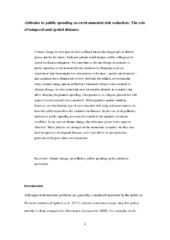| dc.contributor.author | Kysela, Eva | |
| dc.contributor.author | Tvinnereim, Endre | |
| dc.contributor.author | Ivarsflaten, Elisabeth | |
| dc.date.accessioned | 2020-04-08T09:36:55Z | |
| dc.date.available | 2020-04-08T09:36:55Z | |
| dc.date.issued | 2019 | |
| dc.Published | Kysela, Tvinnereim ET, Ivarsflaten E. Attitudes to public spending on environmental risk reduction: the role of temporal and spatial distance. Environmental Sociology. 2019;5(4):362-373 | eng |
| dc.identifier.issn | 2325-1042 | |
| dc.identifier.uri | https://hdl.handle.net/1956/21824 | |
| dc.description.abstract | Climate change is often perceived as a distant threat affecting people in distant places and the far future. Such perceptions could dampen public willingness to spend on climate change mitigation. We contribute to the knowledge on attitudes to public spending on environmental risk reduction by designing a survey experiment that disentangles two dimensions of distance – spatial and temporal – and examines these dimensions for two different, but related, environmental risks: climate change and air pollution. Consistent with previous research on climate change, we find somewhat more favourable attitudes in scenarios that allow delaying the planned spending. This pattern is, to a degree, present for both types of environmental risks examined. With regards to spatial variation, however, we find that the type of environmental risk being addressed matters for how the public responds to the variations in distance. In the case of air pollution, attitudes to public spending are more favourable in the spatially proximate condition. In the case of climate change, the difference points in the opposite direction. These patterns are strongest in the immediate scenarios, but they also hold irrespective of temporal distance, and can be specific to particular political ideological subsets of respondents. | en_US |
| dc.language.iso | eng | eng |
| dc.publisher | Taylor & Francis | eng |
| dc.relation.uri | https://www.tandfonline.com/doi/full/10.1080/23251042.2019.1643528 | |
| dc.title | Attitudes to public spending on environmental risk reduction: the role of temporal and spatial distance | eng |
| dc.type | Peer reviewed | en_US |
| dc.type | Journal article | en_US |
| dc.date.updated | 2020-01-28T09:35:16Z | |
| dc.description.version | acceptedVersion | |
| dc.rights.holder | Copyright Taylor & Francis. All rights reserved. | en_US |
| dc.identifier.doi | https://doi.org/10.1080/23251042.2019.1643528 | |
| dc.identifier.cristin | 1728537 | |
| dc.source.journal | Environmental Sociology | |
| dc.source.pagenumber | 362-373 | |
| dc.identifier.citation | Environmental Sociology. 2019;5(4):362-373 | |
| dc.source.volume | 5 | |
| dc.source.issue | 4 | |
